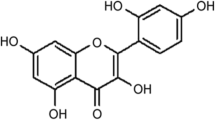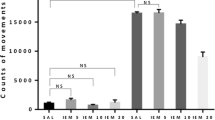Summary
The high selectivity of the phencyclidine derivative PRE-084 for sigma (σ) sites is demonstrated. We previously reported that this compound is able to markedly attenuate the impairment of learning induced in mice by the non-competitive NMDA antagonist MK-801, and the cholinergic nicotinic antagonist mecamylamine. In this study, we examined the effect of PRE-084 on the impairment of learning induced by acute administration of the calcium channel antagonist nimodipine. Nimodipine (0.3mg/kg i.p.) impaired the spontaneous alternation behaviour in a Y-maze, decreased the step-down latency (SDL) in a passive avoidance task, and altered place learning and retention in a water-maze paradigm, with no marked effect on the motility observed using an open-field test. Preadministration of PRE-084 resulted in an attenuation of the impairment of alternation, in the 0.3–1 mg/kg s.c. range, in a marked increase in SDL, at 1–3 mg/kg, and improved place learning and retention in the water-maze, at 1 mg/kg. The effects on alternation behaviour and passive avoidance were completely prevented by co-administration of the purported σ antagonist BMY-14802 (10 mg/kg i.p.), implicating the σ sites. These results confirm the beneficial effect of the σ ligand PRE-084 on pharmacological models of learning impairments, and indicate that σ sites may modulate Ca2+ fluxes through VDCC, which may in turn bear some as yet unknown relationship to the previously described interaction with neurotransmitter systems.
Similar content being viewed by others
Abbreviations
- SDL :
-
step-down latency
- EL :
-
escape latency
- VDCC :
-
voltage-dependent calcium channel
- NMDA :
-
N-methyl-D-aspartate
- LTP :
-
long-term potentiation
- DTG :
-
1,3-di-(2-tolyl) guanidine
References
Anis A, Berry SC, Burton NR, Lodge D (1983) The dissociative anesthetics, ketamine and phencyclidine, selectively reduce excitation of central mammalian neurones by N-methyl-D-aspartate. J Pharmacol Exp Ther 79: 565–575
Bell JA, Spivak CE, Su TP, London ED (1988) Haloperidol-sensitive, selective electrophysiological effects of sigma ligands on NCB-20 cells. Soc Neurosci Abstr 14: 1155
Courtney MJ, Lambert JJ, Nicholls DG (1990) The interactions between plasma membrane depolarization and glutamate receptor activation in the regulation of cytoplasmic free calcium in cultured cerebellar granule cells. J Neurosci 10: 3873–3879
Deyo RA, Nix DA, Parker TW (1992) Nifedipine blocks retention of a visual discrimination task in chicks. Behav Neural Biol 57: 260–262
Earley B, Burke M, Leonard BE, Gouret CJ, Junien JL (1991) Evidence for an antiamnesic effect of JO 1784 in the rat: a potent and selective ligand for the sigma receptor. Brain Res 546: 282–286
Ela C, Barg J, Vogel Z, Hasin Y, Eilam Y (1994) Sigma receptor ligands modulate contractility, Ca2++ influx and beating rate in cultured cardiac myocytes. J Pharmacol Exp Ther 269: 1300–1309
Fletcher EJ, Church J., MacDonald JF (1994) Haloperidol blocks voltage-activated Ca2+ channels in hippocampal neurones. Eur J Pharmacol 267: 249–252
Gould RJ, Murphy KMM, Reynolds IJ, Snyder SH (1983) Antischizophrenics drugs of the diphenylbutylpiperidine type act as Ca2+ channels antagonists. Proc Natl Acad Sci USA 80: 5122–5125
Grover LM, Teyler TJ (1990) Two components of long-term potentiation induced by different patterns of afferent activation. Nature 347: 477–479
Hiramatsu M, Koide T, Ishihara S, Shiotani T, Kameyama T, Nabeshima T (1992) Involvement of the cholinergic system in the effect of nefiracetam (DM-9384) on carbon monoxide (CO)-induced acute and delayed amnesia. Eur J Pharmacol 216: 279–285
Hoffmeister F, Benz U, Heise A, Krause HP, Neuser V (1982) Behavioral effects of nimodipine in animals. Arzneimittelforschung 32: 347–360
Huang YY, Malenka RC (1993) Examination of TEA-induced synaptic enhancement in area CA1 of the hippocampus: the role of voltage dependent Ca2+ channels in the induction of LTP. J Neurosci 13: 568–576
Jahr CE, Stevens CF (1987) Glutamate activates multiple single channel conductances in hippocampal neurones. Nature 325: 522–525
Jones OT, Kunze DL, Angelides KJ (1989) Localization and mobility of Ω-conotoxinsensitive Ca2+ channels in hippocampal CA1 neurons. Science 244: 1189–1193
Junien JL, Roman FJ, Brunelle G, Pascaud X (1991) JO-1784, a novel σ ligand, potentiates [3H] acetylcholine release from rat hippocampal slices. Eur J Pharmacol 200: 343–345
MacDermott AB, Mayer ML, Westbrook GL, Smith SJ, Barker J (1986) NMDA-receptor activation increases cytoplasmic calcium concentration in cultured spinal cord neurons. Nature 321: 519–5226
Matsuno K, Mastunaga K, Mita S (1993) Increase in extracellular acetylcholine level by sigma ligands in rat frontal cortex. J Pharmacol Exp Ther 265: 851–859
Matsuno K, Mastunaga K, Senda T, Mita S (1992) Increase in extracellular acetylcholine level in rat frontal cortex induced by (+)N-allylnormetazocine as measured by brain microdialysis. Brain Res 575: 315–319
Maurice T, Bayle J, Privat A (1995) Learning impairment following acute administration of the calcium channel antagonist nimodipine in mice. Behav Pharmacol (in press)
Maurice T, Hiramatsu M, Itoh J, Kameyama T, Hasegawa T, Nabeshima T (1994a) Behavioral evidence for a modulating role of sigma ligands in memory processes. I. Attenuation of dizocilpine (MK-801)-induced amnesia. Brain Res 647: 44–56
Maurice T, Su TP, Parish DW, Nabeshima T, Privat A (1994b) PRE-084, a σ selective PCP derivative, attenuates MK-801-induced impairment of learning in mice. Pharmacol Biochem Behav 49: 859–869
Mayer ML, Westbrook GL (1987) Permeation and block of N-methyl-D-aspartic acid receptor channels by divalent cations in mouse cultures central neurones. J Physiol 394: 501–527
Meyer H, Wehinger E, Bessert F, Scherling D (1983) Nimodipine: synthesis and metabolic pathway. Arzneimittelforschung 33: 106–1123
Monnet FP, Blier P, Debonnel G, De Montigny C (1991) The modulation by sigma ligands of NMDA-evoked [3H]noradrenaline release involve Gi/o proteins. Soc Neurosci Abstr 17: 1340
Monnet FP, Debonnel G, De Montigny C (1992) In vivo electrophysiological evidence for a selective modulation of N-methyl-D-aspartate-induced neuronal activation in rat CA3 dorsal hippocampus by sigma ligands. J Pharmacol Exp Ther 261: 123–130
Monnet FP, Debonnel G, Junien JL, De Montigny C (1990) N-methyl-D-aspartateinduced neuronal activation is selectively modulated by sigma receptors. Eur J Pharmacol 179: 441–445
Morris RGM, Anderson E, Lynch GM, Baudry M (1986) Selective impairment of learning and blockage of long-term potentiation by a N-methyl-D-aspartate receptor antagonist, AP5. Nature 319: 774–776
Nicoll RA, Kauer JA, Malenka RC (1988) The current excitement in long-term potentiation. Neuron 1: 97–103
Nikolaev E, Kaczmarek L (1994) Disruption of two-way active avoidance behavior by nimodipine. Pharmacol Biochem Behav 47: 757–759
Okuyama S, Imagawa Y, Ogawa S, Araki H, Tanaka M, Muramatsu M, Nakazato A, Yamaguchi K, Yoshida M, Otomo S (1993) NE-100, a novel sigma receptor ligand: in vivo tests. Life Sci 53: 285–290
Paul IA, Basile AS, Rojas E, Youdim MBH, De Costa B, Skolnick P, Pollard HB, Kuijpers GAJ (1993) Sigma receptors modulate nicotinic receptor function in adrenal chromaffin cells. FASEB J 7: 1171–1178
Quirion R, Bowen WD, Itzhak Y, Junien JL, Musacchio JM, Rothman RB, Su TP, Tam SW, Taylor DP (1992) A proposal for the classification of sigma binding sites. Trends Pharmacol Sci 13: 85–86
Quirion R, Lafaille F, Nair NPV (1985) Comparative potencies of Ca2+ channels antagonists and antischizophrenic drugs on central and peripheral Ca2+ channel binding sites. J Pharm Pharmacol 37: 437–441
Rivière PJM, Pascaud X, Junien JL, Porreca F (1990) Neuropeptide Y and JO 1784, a selective sigma ligand, alter intestinal ion transport through a common haloperidolsensitive site. Eur J Pharmacol 187: 557–559
Rivière PJM, Rao RK, Pascaud X, Junien JL, Porreca F (1993) Effects of neuropeptide Y, peptide YY and sigma ligands on ion transport in mouse jejunum. J Pharmacol Exp Ther 264: 1268–1274
Roman FJ, Pascaud X, Duffy O, Junien JL (1991) Modulation by neuropeptide Y and peptide YY of NMDA effects in hippocampal slices: role of sigma receptors. In: Kameyama T, Nabeshima T, Domino EF (eds) NMDA related agents: biochemistry, pharmacology and behavior. NPP Books, Ann Arbor, pp 211–218
Sarter M, Bodewitz G, Stephens D (1988) Attenuation of the scopolamine-induced impairment of spontaneous alternation behavior by antagonist but not inverse agonist and agonist β-carbolines. Psychopharmacology 94: 491–495
Scriabine A, Schuurman T, Traber J (1989) Pharmacological basis for the use of nimodipine in central nervous system disorders. FASEB J 3: 1799–1809
Siniscalchi A, Cristofori P, Veratti E (1987) Influence of N-allylnormetazocine on acetylcholine release from brain slices: involvement of muscarinic receptors. Arch Pharmacol 336: 425–429
Skeen GA, Twyman RE, White HS (1993) The dihydropyridine nitrendipine modulates N-methyl-D-aspartate receptor channel function in mammalian neurons. Mol Pharmacol 44: 443–450
Su TP (1991) σ Receptors: putative links between nervous, endocrine and immune systems. Eur J Biochem 200: 633–636
Su TP, Wu XZ, Cone EJ, Shukla K, Gund TM, Dodge AL, Parish DW (1991) Sigma compounds derived from phencyclidine: identification of PRE-084, a new, selective sigma ligand. J Pharmacol Exp Ther 259: 543–548
Takashima A, Itoh S (1989) Memory impairment induced by CCK-8 antagonists in passive avoidance response of the rat. Drug Dev Res 18: 95–100
Tam SW, Cook L (1984) Sigma opiates and certain antipsychotic drugs mutually inhibit (+)-[3H]SKF 10,047 and [3H]haloperidol binding in guinea pig brain membranes. Proc Natl Acad Sci USA 81: 5618–5621
Taylor DP, Dekleva J (1987) Potential antipsychotic BMY 14802 selectively binds to sigma sites. Drug Dev Res 11: 65–70
Walker JM, Bowen WD, Walker FO, Matsumoto RR, De Costa B, Rice KC (1990) Sigma receptors: biology and function. Pharmacol Rev 42: 355–402
Weber E, Sonders M, Quarum M, McLean S, Pou S, Keana JFW (1986) 1,3-Di-(2-[5-3H]tolyl)guanidine: a selective ligand that label sigma-type receptors for psychotomimetic opiates and antipsychotic drugs. Proc Natl Acad Sci USA 83: 8784–8788
Westenbroek RE, Ahlijanian MK, Catterall WA (1990) Clustering of L-type Ca2+ channels at the base of major dendrites in hippocampal pyramidal neurons. Nature 347: 281–284
Wu XZ, Bell JA, Spivak CE, London ED, Su TP (1991) Electrophysiological and binding studies on intact NCB-20 cells suggest presence of a low affinity sigma receptor. J Pharmacol Exp Ther 257: 351–359
Yamada K, Satoh M, Tokoi J, Tsuboi M, Nagasaka T (1992) Strain differences of mice in learning of swimming behavior and effect of hemicholinium and vasopressin. Observation by a simple water maze apparatus. Yakugaku Zasshi 112: 824–831
Author information
Authors and Affiliations
Rights and permissions
About this article
Cite this article
Maurice, T., Su, T.P., Parish, D.W. et al. Prevention of nimodipine-induced impairment of learning by the selective σ ligand PRE-084. J. Neural Transmission 102, 1–18 (1995). https://doi.org/10.1007/BF01276561
Received:
Accepted:
Issue Date:
DOI: https://doi.org/10.1007/BF01276561




